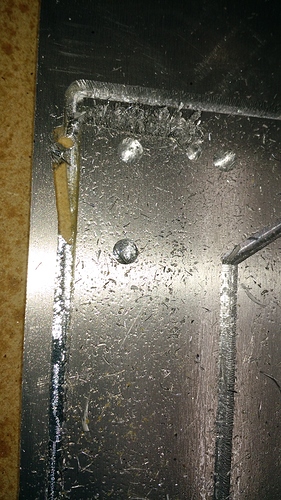Good morning fellow Ox owners quick question in regards to cutting aluminum. I’m working with some 1/4" 6061-t6… I get a bit of chatter while cutting but it’s nothing a finish pass won’t clean up. My real issue is when I’m about 5mm deep while cutting I seem to get some chatter that makes my whole Z,X assembly start to rack and causes loss of steps which you can see in the attached picture. I have the part I’m cutting secured to the table by carpet tape and wood screws in both the part and the surrounding parameter of the object im cutting. Any advice would be much appreciated. Thanks in advance fellow OX owners
we’re going to have to know the bit size, flutes, speed, and rpm
Yeah that’s how I secured mine too. It’s going to be a question of mechanics, your spindle might be crooked, your frame might be resonating, stepper drivers overheating, but ultimately if your machine starts skipping around you need to re-evaluate your speeds and depth of cut.
Please tell what those parameters are and what kind of bit you are using.
.125 (3.18mm) carbide single flute around 11-12k rpm as I don’t own a laser tach I can only assume by the rating on my quiet cut 400w spindle…25ipm (635mm/m) feed and I’m ramping down when i plunge to the next pass…
you might be going too slow, and having aluminum welding to the bit. Try running it at 1200mm/min and a 1mm DOC per pass.
Only change one variable at a time, and use canola oil.
My DOC is around .5 mm don’t think my spindle is beefy enough to do 1mm but I could be wrong…
@raykholo I’ve been using 3-1 oil as a lubricant
I have had issues with ramping especially on holding tabs using a single flute that small. Tends to deflect because the ramping causes a side load, and then engages too much material and pulls things off track. Try to plunge straight on height changes, then continue.
@Eclsnowman now that you mention it, it’s right around the pass where I start the holding tabs
Thanks for all the help guys! I have plenty of aluminum plate to play with and a case full of bits. I just needed a starting point to point me in the right direction. It’s just difficult for me to go from a professional machine to a hobby machine and know where to start with feeds and speeds
@Alex_Krause 12K @ 635mm/m = 0.053mm/tooth (about 0.002 inch per tooth). That is just under where I run, but a good place to start is around 0.001 IPT on aluminum if you don’t know where else to begin. 0.001 should yield enough chip load to avoid rubbing, but is still conservative enough to run on most machines. I would start there and increase chip load until you are happy with the finish and how it sounds. Then start increasing DOC until you start running into problems… then back it off from the failure point to get a margin of safety.
Here are a few cheat sheets that might help as you play around: http://imgur.com/a/tDE7a
Thanks @Eclsnowman I’m going off suggested IPT data included in my machinist calc that is the only resource I had to go with they suggested .003 chip load so I backed it off a bit
@Alex_Krause are you using belts on X and Y axis?
I think those belts can’t support high chip load because X gantry belt is too thin and elastic to mill aluminum then tool begin to do tiny jumps.
This is hypotetical.
Make sure your settings are for motors on while in motion. You want all motors on not just the axis in movement. That helps keep the other axis from moving out of position when for example the Y axis is moving. Otherwise your axis not in movement is an idle sitting duck.
